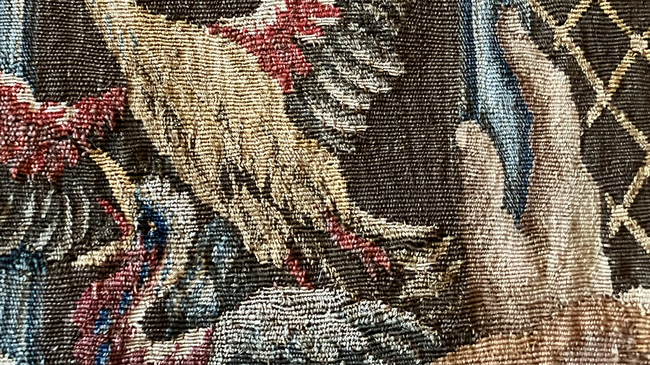Technique
Tapestries are textile works of art par excellence which have been made using a specific weaving technique known as the tapestry technique. This allows a virtually endless variation of images to be woven in wool, silk and – for the most valuable pieces – gold and silver thread. This includes scenes from biblical and mythological stories and historical events – often with larger-than-life figures – but also landscapes and more decorative motifs featuring plants and flowers. The image is created directly on the loom. In this it differs from embroidery, which involves working on fabric that has already been woven. In most cases, weavers worked on looms with a horizontal warp, the so-called ‘basselisse’ technique. Here the warp threads of unbleached wool or linen are stretched between two long rollers. The length of the threads corresponds to the width of the tapestry that is to be woven; they are coiled around the roller the furthest away from the weaver. Each warp thread features a loop that leads to slats at the bottom of the loom; one slat for the even threads and a second slat for the odd threads. By moving a pedal, one slat lowers while the other rises. This creates space for the coloured threads, with which the scene is woven.
The weft thread, wound around bobbins, is alternately guided from left to right through the alternating opening of the warp threads. When weaving, the warp threads are completely covered, resulting in a characteristic ribbed structure. (Fig. 1)
Specific to the tapestry technique is that the weft threads of a given colour do not run continuously from selvedge to selvedge, but only cover the part of the warp that corresponds to the underlying pattern.
This pattern featuring the full-size painted scene is called the cartoon. This cartoon is placed under the warp threads and thus the weavers work on the rear side of the tapestry where the loose threads remain. As a result, the woven depiction is the mirror image of the cartoon.
The weavers also work from the side of the tapestry. This means that the height of the tapestry corresponds to the width of the loom.
The difference in the fineness of the weave depends on the number of warp threads used, which are visible as ridges in the weave surface. This can vary from four to five warp threads for fairly coarse tapestries, mostly woven in wool, to ten to twelve warp threads for extremely fine weaves, which include a lot of silk.
Tapestries can have large dimensions, no less than over four metres high and sometimes up to ten metres wide. Tapestries were often also manufactured in sets to cover the walls of a given room (Fig. 2).

Fig. 1
Detail of cat. 64. Photo: R.J. Beerens

Fig. 2
wandtapijtweverij van Maximiliaan van der Gucht naar ontwerp van Anoniem ca. 1670
Reeks landschapsverdures met dieren, ca. 1670
Oud-Zuilen, Slot Zuylen, inv./cat.nr. Inv. 228 (afd. 228 K VIII)

